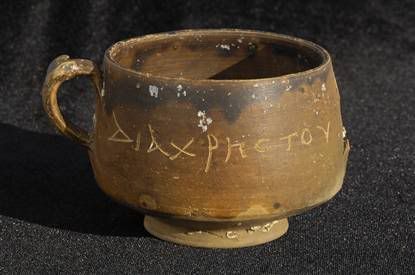
“Was Jesus Christ a magician?,” asks a Times of India headline. In fact this query comes from a recent discovery of a bowl in Alexandria by French marine archaeologists.
The full engraving on the bowl reads, “DIA CHRSTOU O GOISTAIS,” which has been interpreted by French epigrapher and professor emeritus Andre Bernand as meaning either, “by Christ the magician” or “the magician by Christ.”
“It could very well be a reference to Jesus Christ, in that he was once the primary exponent of white magic,” Goddio, co-founder of the Oxford Center of Maritime Archaeology, said.
For a moment assume that this inscription actually reads “by Christ the magician” and the Christ here refers to Yeshua, then it brings up few issues which have been suppressed by the gospel writers.
In the opening scene of The Betrayal: The Lost Life of Jesus: A Novel by Kathleen O’Neal Gear and W. Michael Gear, two Zealots, Dysmas and Gestas, come to meet Yeshua asking him to be their leader in attacking the Romans. During the entire conversation they call him “magician”.
In the footnotes of the book the authors mention that gospel translators took out most references to Yeshua as a magician, but still some remain. When Yeshua is taken to Pilate he is referred to as an evil doer, which in Roman terminology referred to a magician. Suetonius in the Life of Nero writes that Christians were involved in magical practices and sorcery. The magician role of Yeshua is also mentioned in Morton Smith’s Jesus the Magician and John Hull’s Hellenistic Magic and the Synoptic Tradition, but this aspect is seldom seen in modern biblical studies.
The problem with the inscription on the bowl is that it does not refer to either “Christ” or “Magician”
This cup has nothing to do with Christ. The Greek on the cup has CHRESTOU not CHRISTOU (or CHRSTOU as the newsreport has it!). CHRESTOU was a well-known title for one of the Sethian Gnostic archons, ATHOTH. It means “EXCELLENT ONE”. It is found in several Sethian texts, including the Gospel of Judas. I do not yet know what OGOISTAIS is, but I am going to work on it. But it doesn’t mean “magician.” This magical bowl is possibly a GNOSTIC magical bowl with an invocation to ATHOTH on it. So don’t believe the hype for minute. This bowl had absolutely nothing to do with CHRIST or with CHRIST as a magician. BUT it is totally fascinating if this object is actually SETHIAN! [Magical Cup has nothing to do with Christ]
The bowl was dated to the late 2nd century B.C. and the early 1st century A.D which means
it cannot in any case refer to Jesus Christ. The epithet Christ was not added to the name of Jesus of Nazareth until after the crucifixion, in the 30’s of the first century. And Jesus of Nazareth did not exist in the 2nd or 1st century BCE (unless he was an infant in the closing years of the 1st century BCE, as seems probable). [The Jesus Bowl: Another Crock]